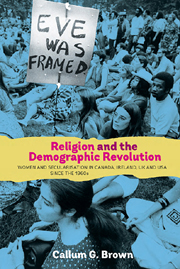 Religion and the Demographic Revolution
Religion and the Demographic Revolution 4 - Sex and religion
Published online by Cambridge University Press: 05 April 2013
Summary
Introduction
At the foundation of the modern history of demographic change is the sexual revolution. Sex in the sixties is not well covered in the literature and what there is tends to concentrate on marital sexuality. Yet, most historians agree there was a sexual revolution, but disagree about when it started, how gradual or revolutionary it was, how far it was shared across all Western countries, and of course whether it has been a ‘good’ or a ‘bad’ thing (and what criteria are to be brought to that judgement). There is then the much thornier issue whether a sexual revolution had anything to do with religion.
This study is primarily concerned with premarital heterosexual sex (especially intercourse) and, to a lesser extent, gay sexuality. The argument in this chapter is composed of a series of points. First, the sexual revolution of the long sixties was a very significant change in social mores, sexual encounters, and popular acceptance—notably of penetrative heterosexual intercourse, increasing popularity of diverse behaviour, and gay sexuality. Accompanying these changes was transformation in the nature of human respectability, especially for women, and these changes were part-and parcel of the liberationist revolution of the period; as Beth Bailey has written of USA: ‘sex was actively claimed by young people, and used not only for pleasure but also for power in a new form of cultural politics that shook the nation’.
- Type
- Chapter
- Information
- Religion and the Demographic RevolutionWomen and Secularisation in Canada, Ireland, UK and USA since the 1960s, pp. 127 - 171Publisher: Boydell & BrewerPrint publication year: 2012


